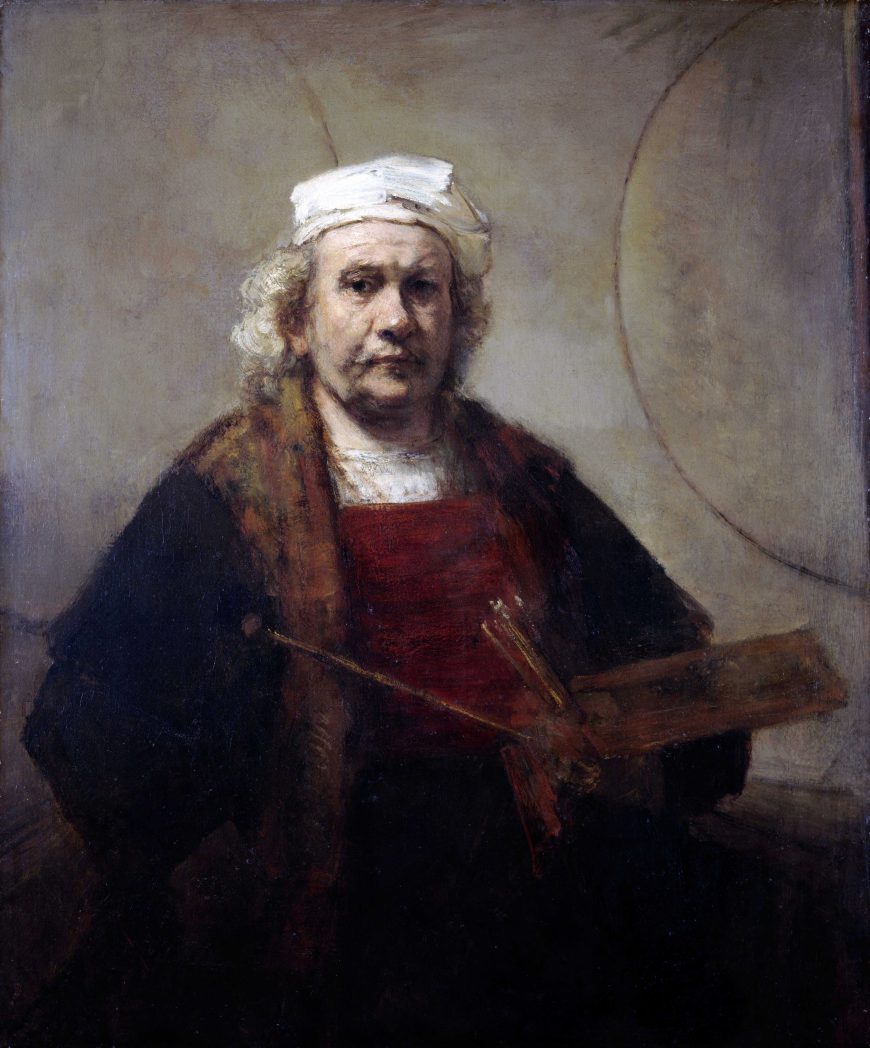The painter and the painted
An old man in a white cap stares out at the viewer with a penetrating gaze. His left hand holds his hastily painted palette, brushes and maulstick, while his right hand seems to disappear in an unresolved blur into his thigh or the folds of his coat. He wears a red bib over a white shirt, with a fur lined coat on his shoulders. Some viewers perceive a gold chain, usually a mark of high honor, tucked into the folds of his garments.
The right edge of the canvas reveals the edge of the painting the artist is working on, while the back wall is adorned with two enigmatic arcing lines. The painting is not signed and is most likely unfinished. Technical studies suggest that it may have originally been slightly larger, which would have made the painting within the painting more prominent.
This is Rembrandt in the early 1660s —late in his career and during a period when he used thick impasto and dark colors to build up complex and engaging works of art. Scholars have regarded this particular self-portrait, one of many from the last decade of his life, as perhaps the most enigmatic and masterful of them all. It stands out from approximately 80 other self-portraits because of its light-toned background, which emphasizes the strangeness of the two circles that arc across the wall.
Self-portraits as self-exploration
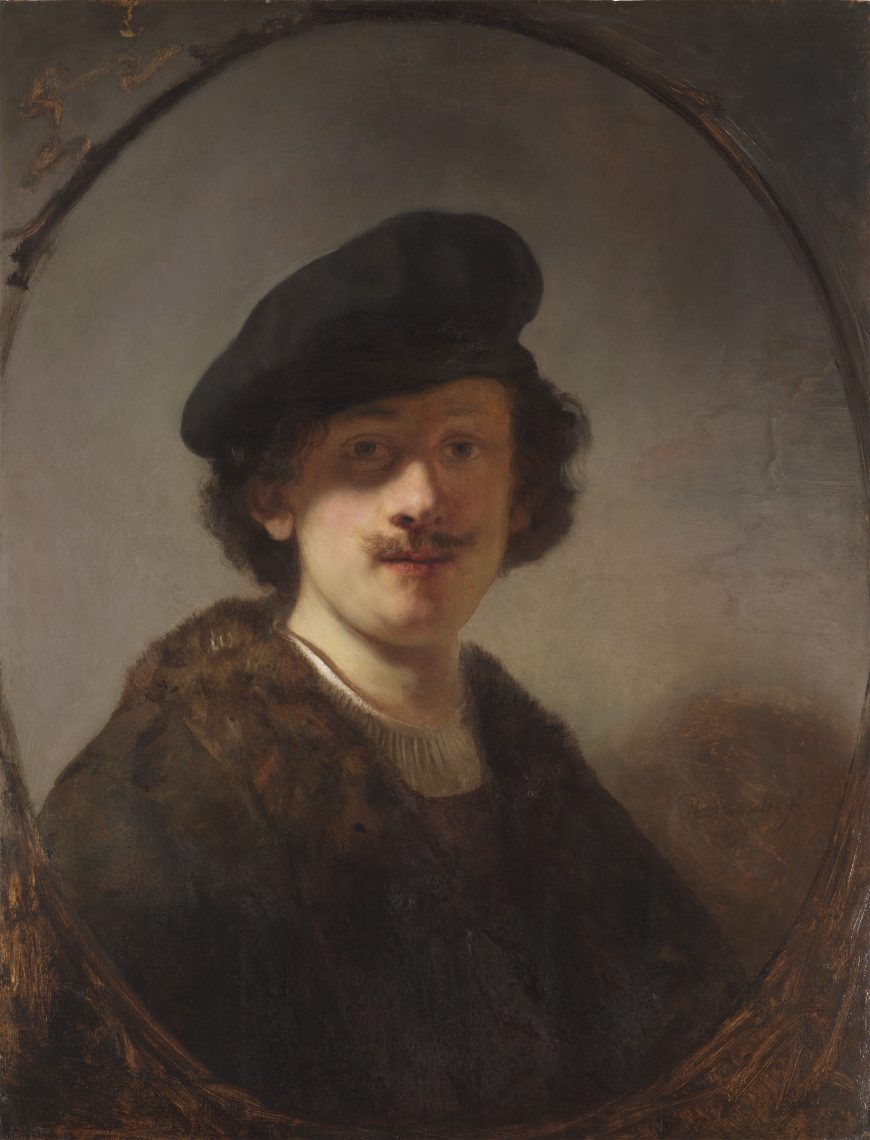
Rembrandt, Self-portrait with Shaded Eyes, 1634, oil on panel, 71.1 x 56 cm (The Leiden Collection)
Approximately ten percent of Rembrandt’s output of paintings and prints consisted of self-portraits. This surprisingly high number is even more impressive when you take into account that each print would have existed in numerous copies — perhaps reaching into the hundreds per image.
Why was Rembrandt so captivated with reproducing his own image? Scholars have approached the self-portraits in a variety of ways: as reflections on Rembrandt’s own psychological state, as evidence of the artist’s stylistic and technical development through his life, as a sophisticated technique of self-promotion, and as a means of theorizing about how Rembrandt perceived the role of the artist in society. Fortunately, many of these interpretations can coexist and overlap.
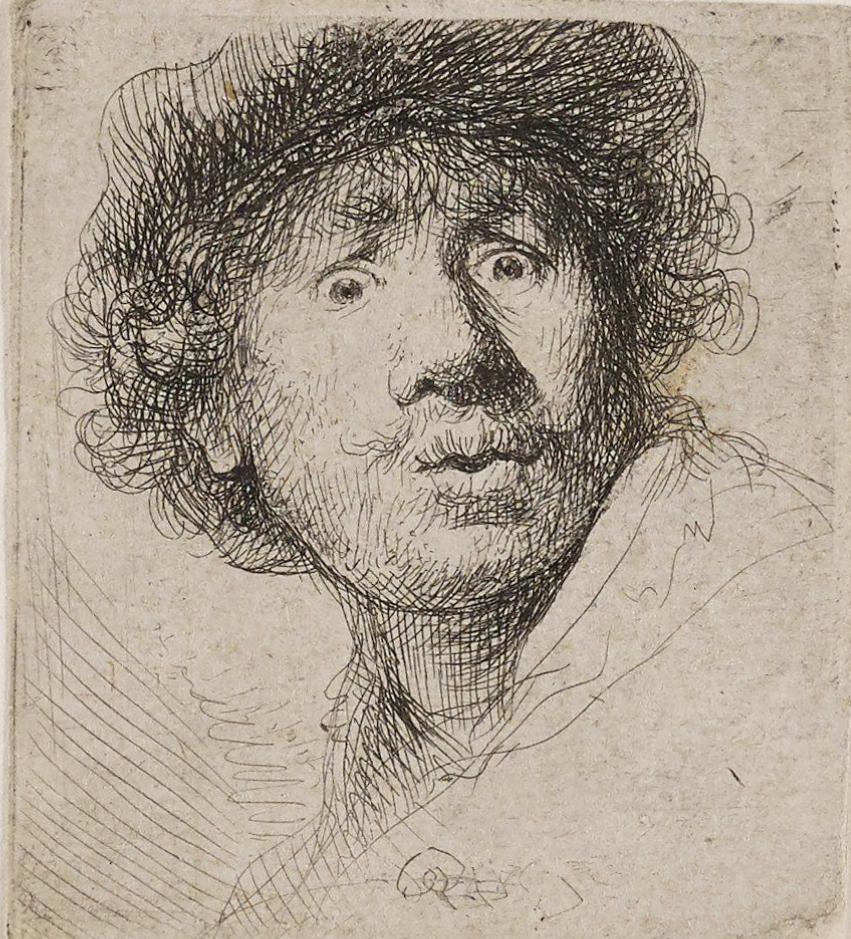
Rembrandt, Self-Portrait with Eyes Wide Open, 1630, etching and drypoint, 5.2 x 4.5 cm (The William M. Ladd Collection Gift of Herschel V. Jones, The Minneapolis Institute of Art)
Rembrandt’s almost obsessive relationship with his own visage could be viewed as a process of self-exploration, a way he took stock of who he was at different points in his career. In some ways, this might seem consistent with the seventeenth-century Calvinist mindset within which Rembrandt would have been raised, a mindset that advocated intense personal responsibility for the state of one’s own soul.
Surely, if Calvinist artists were used to routinely scrutinizing their own actions and motives, then also scrutinizing their own faces makes a certain sense (Calvinism became the official religion of the Dutch Republic in 1648). In that regard, many scholars (for example, Perry Chapman) have perceived the self-portraits as deeply personal. This feels very appealing to us as viewers, because we want to try to humanize artists from the past. However, many leading Rembrandt scholars approach autobiographical psychologizing with skepticism because they argue that it is based in an understanding of the self that is rooted in twentieth-century psychological practices.
Rembrandt’s early self-portraits and the many small engraved and etched ones can perhaps be fruitfully interpreted through the application of early modern art theory and ideas about artistic training. As Marjorie Wiesman has noted, when writing didactic texts for painters in the early modern period, authors such as Franciscus Junius (1637) and Karel van Mander (1604) advised artists to examine their own inner emotions so that they would know how to project those emotions into the scenes that they created. Studying the impact of different emotions on bodies and faces was recommended as a means to make a painter a stronger artist. Many of Rembrandt’s early etched and engraved portraits (such as Self-Portrait with Eyes Wide Open) do exactly this, and yet the painted self-portraits (such as Self-portrait with Shaded Eyes primarily) seem to represent him calmly regarding the viewer. We can therefore conclude that he created different self-portraits for different reasons.
The economics of (self) portraiture
Since the work of John Michael Montias on the economics surrounding Johannes Vermeer and the city of Delft, market forces and economic theory have been fruitfully applied to Dutch art of the seventeenth century. In the case of Rembrandt’s self-portraits, we might ask: who was buying all of these self-portraits? If a self-portrait is regarded not as an internally reflective meditation on self and identity as an end in itself, but as a commodity, different avenues of analysis emerge. A self-portrait not only represents the painter visually, but also does so by quite literally showing the technique of the painter. In that regard, they functioned as advertisements that opened the door to future commissions.
During Rembrandt’s own lifetime, eminent figures such as King Charles I of England, Cosimo de’ Medici, and the art dealer Johannes Renialme were known to have owned self-portraits by the artist. At some points in his career, self-portraits clearly sold briskly. And yet a group of several paintings of generic men in moustaches and hats from the studio of Rembrandt reveal, when x-rayed, that they were self-portraits by Rembrandt to which his students later added accessories in order to convert them to character studies. This implies that the self-portraits were no longer selling and were therefore converted into something that would. The fact that there was not a single self-portrait listed among the art and objects inventoried at the time of Rembrandt’s bankruptcy in 1656 furthers our interpretation of the self-portrait as commodity. If they were primarily intended as personal explorations of the internal life of the artist, surely he would have kept at least one.
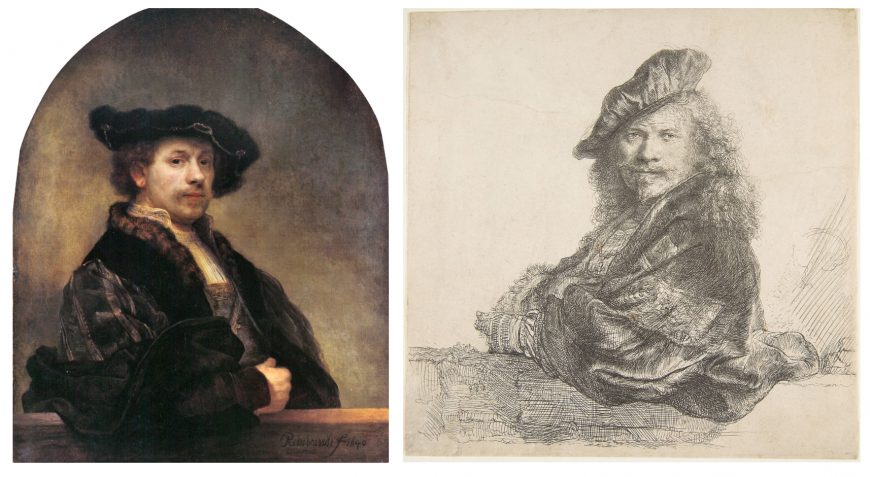
Rembrandt, Self-portrait (left), 1640, oil on canvas, 102 x 80 cm (National Gallery, London) and Self-Portrait, Leaning on a Stone Wall (right),1639, etching, 16 x 16 cm (The Metropolitan Museum of Art)
Recently, Marjorie Wiesman has approached Rembrandt’s self-portraits chronologically, separating them into earlier, brasher paintings where he appears youthful and passionate, mid-career works where he acknowledges and advances his rise to fame, and later, mature works that ruminate on the nature of old age and art as a profession. Portraits of the late 1630s and 1640s (mid-career) seem to chronicle his rise to the peaks of artistic accomplishment, particularly the famous painted portrait of 1640 and the companion print from 1639 (see above).
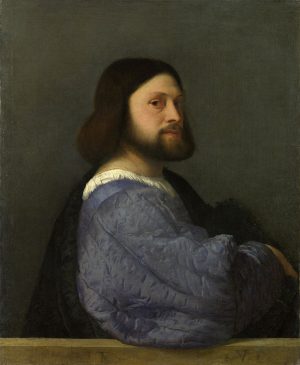
Titian, Portrait of a Man – Gerolam Barbarigo?, c. 1510, oil on canvas, 81.2 x 66.3 cm (National Gallery, London)
In both painted and printed versions of this portrait composition, Rembrandt dresses himself in a gaudy jacket, and chains and brooches adorn his feathered beret. Moreover, he leans on a windowsill with one elbow, inserting himself into a tradition of portraiture used by artists such as Titian and Raphael. He had seen Raphael’s portrait of Baldassare Castiglione at auction in Amsterdam, even noting on his sketch how much it sold for. He was also familiar with Titian’s Portrait of a Man – Gerolam Barbarigo? By mimicking these two great masters in his own self-portrait, Rembrandt’s posture and attire underline that — like Titian and Raphael — he is a man of means and talent. His self-portrait became a tool for advertising to potential investors and securing a place for himself in Amsterdam society and art history.
Self-portrait with Two Circles at Kenwood House
By the 1660s, however, Rembrandt was no longer presenting himself in the same way, perhaps because he was no longer seeking the same kind of audience he had in the earlier parts of his life. Nearing the end of a long and tempestuous career, the late self-portraits take a different, more somber tone. The Self Portrait with Two Circles at Kenwood House is one of the great examples of the last decade of the artist’s life. It has enticed generations of scholars because of the two incomplete circles on the back wall. A definitive explanation for those circles has yet to be agreed upon, but several compelling suggestions have been made.
One interpretation identifies the circles as the two hemispheres shown on a world map of the time. It would not be unusual for a large wall map to be hanging as a backdrop for a painting; wall maps were commonly depicted in the background of seventeenth-century genre scenes by artists like Johannes Vermeer. The problem with this interpretation, according to the detractors (who include Ernst van de Wetering and the Rembrandt Research Project is that the circles are too far apart to represent the two circles of a map, and that the wrinkling and curling of maps on walls seen in other paintings is not present here.
A more philosophical interpretation, proposed by Jan Emmens, suggests that all artists needed to have ingenium (inborn genius), ars (theory or learned knowledge), and exercitatio (or skill gained through practice). In this interpretation, the figure of Rembrandt stands in for Ingenium, while the circles behind indicate theory (ars) and the canvas at the edge of the picture plane speaks to exercitatio.
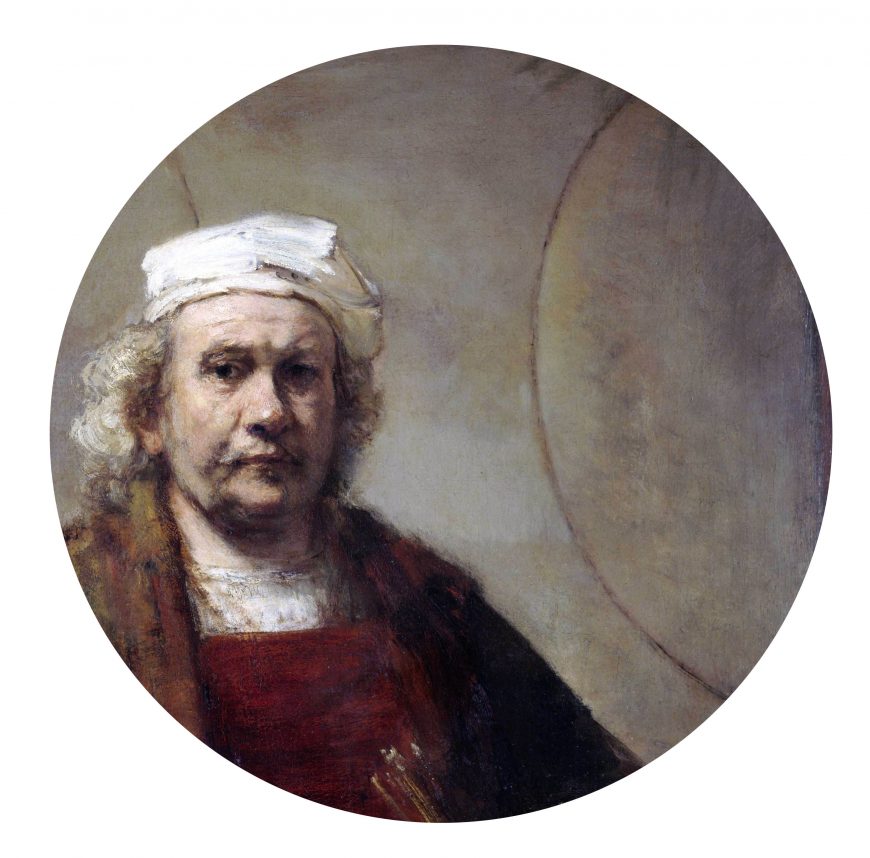
Rembrandt, Detail from Self-portrait with Two Circles, c. 1665 – 69, oil on canvas, 114.3 x 94 cm (Kenwood House)
Perfect circles and artistic greatness
Several other scholars, including B. P. J. Broos and Jeanne Porter, connect the drawing of circles with ideas about art theory expressed in contemporary sources. In Het Schilderboek (The Painting Book) (1604), Karel van Mander repeats a famous story from Vasari — that Giotto could draw a perfect circle freehand at a young age. It is a demonstration of an innate skill, the height of perfection. This type of story, that is, about creating the perfect line, can be traced to classical antiquity where the great artist Apelles was also known for drawing the perfect line. Yet in the Kenwood portrait, Rembrandt’s circles are not perfect circles made with single, fluid lines; they are made up of his more characteristic short, interrupted strokes and they are themselves interrupted by the boundaries of the image.
Ben Broos has suggested that the painting reveals “perfection” in a particularly Rembrandt-esque manner. Rembrandt’s late work is defined by heavy impasto and choppy brushwork. By using that technique to create a perfect circle, the artist appropriates a motif from the tradition of artistic biographies and the legends of artistic greatness but makes it fully his own, both in how it is painted and in using it as a backdrop for a self-portrait. The Kenwood self-portrait could be making a claim for the artist as the pinnacle of greatness, situating himself alongside other masters in the long history of art.
A definitive interpretation of the circles remains elusive, and every generation of Rembrandt scholars proposes a new reading of the motif. What’s yours?

